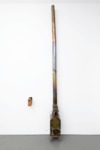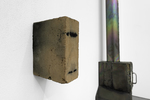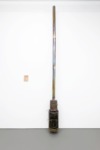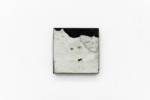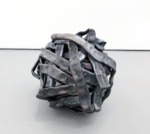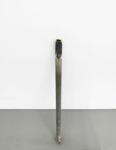Henry Staschik – Amore Amaro
„Bitter Love“ is the name of an Italian film drama set in Mussolini‘s Italy. A bitter is also allegedly to be called that. And a bitter is known to be a remedy that is administered in case of discomfort. Even the sweetest love often results in an a posteriori discomfort. Just think of James Cagney in his starring role as a good-hearted gangster boss who grasps the chin of the lady of his choice so roughly that she screams in pain, whereupon he explains to her and the rest of the world: „THAT IS LOVE“.
In the exhibition at Åplus, whoever strives to spot the biggest first notices a lattice-like object that looms from the wall into the room. This room divider, welded together from construction scrap, consists of various edge and angle sheets that confine its quadratic shape and at the same time provide the necessary statics. In the middle parades an amorphous form made of monier steel and, further down, a two-part, sturdy link chain, held together by a padlock.
Perchance, this find may hold proof of a successful theft.
For the works to the left and right of the room divider, Henry Staschik asked fellow artists to supply him with the wooden packaging in which their works of art were temporarily stored or transported. These now empty containers are filled with clay, as is the case with plaster in criminal forensics, and fired in a specially welded oven with separate combustion chambers until the transport box finally burns and only the ceramic block
remains. In the exhibition, the „piece of evidence“ and its combustion unit now hang as an ensemble on the wall or stand on pedestals just as the artwork that once owned the packaging would have been presented.
At first, it is a rather elaborate instruction of the conceptual art world, yet space is created here for all kinds of further questions. Thus, for example, the Christian layman can ponder whether a relic is really a carrier of divine energy or only a memory aid, so that things or actions do not fall into oblivion. Does a work of art have something like an aura that sticks like chewing gum to everything it touches? Or is there a superhuman
occurence, like the veil of Veronica, that longs to be brought into visible form?
And finally there is a really small picture that, despite its tiny size, is the most disturbing factor in the exhibition. A find, an old industrial tile, whose traces of use are reminiscent of a landscape with a starry sky or, due to two perfectly set indentations, a face. This is exactly what Henry Staschik supports by equipping the found object with eyelashes and a pupil. Perhaps this is also serves as a ghostly after image, a memory that has become reality, e.g. of a great love? If so, the lock on the chain is a proof of love.
Patrick Huber
Translation: Robert Loos
Henry Staschik – Amore Amaro
„Bittere Liebe“ so heißt ein italienisches Filmdrama, das im Italien Mussolinis spielt. Auch ein Magenbitter soll angeblich so heißen. Und ein Bitter ist ja bekanntlich ein Mittel, das bei Unbehagen verabreicht wird. A
posteriori erzeugt selbst süßeste Liebe oft ein Unbehagen. Oder denken wir an James Cagney in seiner
Paraderolle als herzensguter Gangsterboss, der der Dame seiner Wahl so grob ans Kinn fasst, dass sie vor Schmerz aufschreit, woraufhin er ihr und dem Rest der Welt erklärt: „DAS IST LIEBE.“.
In der Ausstellung bei Åplus fällt dem Menschen, der immer erst das Große sieht, ein gitterähnliches Objekt auf, das von der Wand in den Raum ragt. Dieser aus Bauschrott zusammengeschweißte Raumteiler besteht aus diversen Kant- und Winkelblechen, die seine rechteckige Form definieren und zugleich die nötige Statik geben. In der Mitte rankt eine amorphe Form aus Monierstahl und weiter unten eine zweiteilige, derbe
Gliederkette, die durch ein Hängeschloss zusammengehalten wird.
Möglicherweise ist dieses Fundstück der Beweis eines gelungenen Diebstahls.
Für die Arbeiten links und rechts des Raumteilers ließ sich Henry Staschik von Künstlerkollegen und
-Kolleginnen hölzerne Verpackungen geben, in denen ihre Kunstwerke eine zeitlang gelagert oder
transportiert wurden. Diese nun leeren Behältnisse werden, wie es die kriminalistische Spurensicherung mit Gips tut, hier mit Tonerde ausgefüllt und in einem jeweils eigens dafür geschweißten Ofen mit separierten Brenn- und Verbrennungskammern so lange gebrannt, bis am Ende die Transportkiste verbrennt und nur der Keramikklotz übrig bleibt. In der Ausstellung hängen nun das „Beweisstück „ und seine
Verbrennungseinheit als Ensemble an der Wand oder stehen auf Sockeln ganz so, wie das Kunstwerk, das einmal Besitzer der Verpackung war, präsentiert worden wäre.
Zunächst geht es hier um eine recht aufwändige Handlungsanweisung der konzeptuellen Kunstwelt, doch wird hier Platz geschaffen für alle möglichen weiteren Fragen. So kann z. B. der christlich veranlagte Laie sinnieren, ob eine Reliquie wirklich ein Träger göttlicher Energie ist oder nur eine Erinnerungshilfe darstellt, damit Dinge oder Handlungen nicht in Vergessenheit geraten. Hat ein Kunstwerk so etwas wie eine Aura, die wie ein Kaugummi an allem, was sie berührt, kleben bleibt? Oder gibt es wie beim Schweißtuch der Veronika ein übermenschliches Geschehen, das in sichtbare Form gebracht werden will...
Am Schluss hängt da noch ein wirklich kleines Bild, das trotz seiner Winzigkeit den größten Störfaktor in der Ausstellung bildet. Ein Fundstück, eine alte Industriefliese, deren Gebrauchsspuren an ein Landschaftsbild mit Sternenhimmel erinnert oder aber auch aufgrund von zwei Vertiefungen an den richtigen Stellen ein
Gesicht darstellt. Genau das unterstützt Henry Staschik, indem er das Fundstück mit Wimpern und einer Pupille ausstattet. Vielleicht ist auch dies ein Geisterbild, eine zur Realität gewordene Erinnerung z. B. an eine große Liebe? Wenn ja, dann wäre das Schloss an der Kette ein Liebesbeweis.
Patrick Huber



